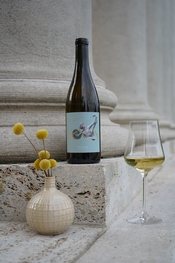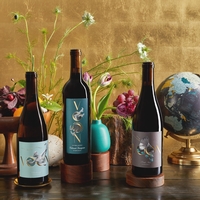I hope he is still in business this time next year.
You see, Anderson does not himself grow grapes. Nor does he “own” a structural winery. Nor make the wine himself, even though he is very involved with the wine’s profile.
What Anderson has done beautifully is to create a virtual winery. It is a dream many people in the wine trade, as well as wine-bedazzled consumers, have often  contemplated – making your own wine with your own commercial label, perhaps even a very good wine where you call the shots but don’t encounter the up-front investments needed to rent, buy or construct an actual building or outfit it with equipment or hire a permanent staff to work for you.
contemplated – making your own wine with your own commercial label, perhaps even a very good wine where you call the shots but don’t encounter the up-front investments needed to rent, buy or construct an actual building or outfit it with equipment or hire a permanent staff to work for you.
But here’s the rub in that scenario, one that Anderson is dealing with now. After you get past the fun of the launch parties and selling a few cases to family and friends, how do you get rid of the rest? If there isn’t already an axiom, there should be one – “Making your own wine is easy. Selling enough of it make a profit is hard.”
“I’m not selling as much wine as I would like,” Anderson honestly admits when I talked with him recently – virtually, of course.
Anderson is a Maryland native who moved to San Francisco in 2017 for a day job with Apple. He had worked in restaurants before, but had not yet fallen in love with wine. By 2020, however, he had not only become entranced by California’s unofficial adult beverage of choice, but he had also begun daydreaming of producing his own wine. He began by taking an online winemaking certification program from U.C. Davis. The fly was cast, and the hook was set.
Like any proud, would-be owner starting a virtual winery, Anderson first had to decide what to call it.
“I spent six months looking at data about winery names, and everything I came up  with already was trademarked,” he says. “Then someone in the family said, ‘Why don’t you call it Voon?’ which was my childhood name.”
with already was trademarked,” he says. “Then someone in the family said, ‘Why don’t you call it Voon?’ which was my childhood name.”
I don’t ask why “Voon?,” and I don’t make a pun about “Voon’s Farm Wine,” as only people of a certain age would get it. I also didn’t say anything about his wanting to refer to his winery name in all caps – VOON – which many businesses, including a couple of other California wineries, do to presumably shout for attention.
“The wine is made from premium grapes at a contract winery on the Central Coast,” Anderson tells me. He contracted Jessica Garcia, who also has her own label – Story of Soil – to make the wine.
Anderson doesn’t need the all-capitals logo to draw attention to his wines. The labels are very arty and tastefully done (to see them and perhaps buy some wine, check his website – www.voonwines.com) and the wine is very good. So far, I’ve tasted the Voon Grüner Veltliner ($38), Chardonnay ($48) and Pinot Noir ($68), all from Sta. Rita Hills. All are enjoyable, sound and well made.
I found the Grüner to be my favorite – refreshing but firm green fruit flavors, predominantly lime, with some minerality and with good structure. The Pinot had soft cherry fruitiness and was well-structured with light bitters around the edges – very nice if not distinctive. I might expect a little more for the price, but not totally out of line. The Chardonnay was a little on the floral side with softer apple flavors  and baking spices, but also somewhat distinctive with a little oxidation actually adding a positive element to the fruit.
and baking spices, but also somewhat distinctive with a little oxidation actually adding a positive element to the fruit.
So now we are back to the question of selling the wine. One way is DTC (direct to consumer) if you have a tasting room, with or without a winery, or can use someone else’s tasting room. Another is online sales, but, as Anderson notes, “shipping costs are killing me.” The traditional way is to pay for a wholesaler or distributor to market your wine. But that comes with both a cost – the distributor’s cut, assuming you can get one to take on a small-volume, untested producer – and a challenge.
The challenge is one of classic marketing. Ideally, a product should be “pushed” by the wholesaler and “pulled” by retailer or customer demand. Supporting a product through PR to get to writers and influencers or through sales incentives to urge retailers to stock it and give it good shelf space and, similarly, through free samples, on-premise wine dinners, off-premise tastings, shelf-talkers and other collateral all take time and money.
These are all costs a new, small winemaker like Anderson may not be able to afford. In a perfect world, all this can be done gradually by first selling out most of a vintage and gain enough cash to invest in more sales incentives to build on the next vintage. Or else take an investor – which so far Anderson has resisted, as having a partner gives up a piece of the vision and control.
To his credit, Anderson seems concerned, but not worried.
“If I can’t sell what I make, I’ll make less,” he says. But how many vintages of making less is an answer?
Either way, I wish him luck. And look forward to the next vintage of Voon.
